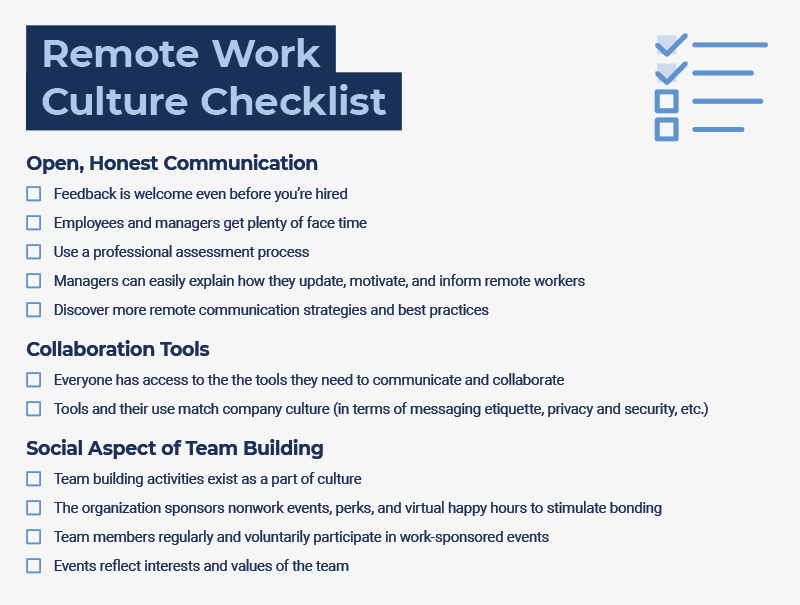What Is Company Culture?
The phrase company culture refers to the values and behaviors that contribute to an organization’s unique environment, norms, and policies. Culture includes a company’s goals, mission and vision statements, ethics, and employee and team expectations.
Culture is an intangible element that you actively build through on-the-ground behaviors and actions that reflect your stated company vision and goals. A variety of elements contribute to company culture, including policies around hiring, promotions, and benefits, as well as “soft” factors like dress code, social norms, and the tools and apps you use to support your organization.
Why It’s Important to Maintain Company Culture with a Remote Team
It’s now widely understood that having a robust company culture improves employee satisfaction and retention. In 2018, Forbes reported that 94 percent of executives understand that a distinct, strong culture directly contributes to a company’s success. As many companies increasingly turn toward flexible or remote work policies, a focus on cultivating a work culture becomes even more important to keep team members from feeling alienated.
But in order to reap the benefits of creating a positive work culture, you’ll need more than an optics-driven social media strategy that promotes your internal brand. While social media can be a tool — especially when team members are not co-located — Deloitte research found that what management perceives as an effective social media culture-building strategy often differs from what resonates with employees.
How to Build a Strong Culture with a Remote Team
The key to building a successful culture for a remote team is understanding the unique challenges remote work poses and tailoring traditional team-building methods to meet those needs. Open, honest, reliable communication is essential.
When working remotely, prioritize face time with team members. One-on-one or small group virtual meetings go a long way in setting the tone (that is, interpersonal culture) of your workplace. Hold virtual retreats, seminars, team off-sites, and training sessions, but bring the same level of enthusiasm to these mediated events.
That said, look for ways to incorporate in-person interaction as appropriate: Use local offices when possible (especially for activities like onboarding), and make sure the physical office space feels appealing and creative. To keep things lively, consider organizing low-stress social activities, such as lunchtime workouts or weekly happy hours, or higher-investment get-togethers like community events.
With fewer in-person (or even virtual) interactions, go the extra mile to foster real connections with your team. Celebrate personal and team accomplishments, and connect team members with those in other departments or younger hires needing mentors, or as part of specific onboarding groups. These actions help people feel included in a larger company network.
Additionally, set a culture around how you use tools to communicate and collaborate remotely. Effective remote team managers learn their employees’ point of view and have (or at least try to gain) experience working remotely for the company. With their input, your choice of the right technology can be an important contributor to a successful remote work culture. You can also help by conveying the functional reasons behind technology choices to the team.
Managers can use instructional tools and apps as well as screen sharing tools to demonstrate what they expect of employees. They can also share calendaring tools, virtual intranet or “watercooler” hangout spaces (which should offer the employee casual one-to-one contact with colleagues as well as one-to-group communication), and meeting tools.
Peruse our comprehensive list of tools you can use to support remote culture building (and other remote work) to find solutions that could work for your team.
Remember, how you work remotely reflects culture, too. Pay attention to how you talk to customers, communicate with team members, and how much (and when) you are working. All of these patterns of behavior contribute implicitly to what employees view as company norms.
Below is a list of general tips for stimulating and promoting a strong remote culture:
- Hire the right people.
- Create rituals and traditions that you can maintain remotely.
- Hold people accountable, even as you are empathetic of extenuating circumstances.
- Ensure stated company values reflect how the company actually acts, not the other way around.
- If possible, establish dual-working teams, where some team members work from home and others at the office.
- Send remote workers elements of the in-office work culture (i.e., company swag, desktop trinkets, etc.).
- Offer perks and in-office opportunities, as appropriate.
- Schedule meaningful, fun social time and have your team participate in team building activities. For a comprehensive list, read “56 Fun, Easy, and Effective Team-Building Games for Remote Workers.”
- Institute a strong remote work policy. For an in-depth guide of how to do so, read our article on creating an effective remote work policy.
In order to build culture, remote employees need to build relationships within the office to feel at home, loyal, and motivated — but that’s tricky when these employees are miles away behind screens at home. Many companies working with remote teams use a social intranet app or tool that lets professionals set their status as “nearby” and “available” while they tackle their work. Skype, Slack, or an internal instant messaging system can be helpful in providing a “watercooler” function for quick work questions or the little social breaks most full-timers take when they complete a task.
Inna Shevchenko is the CMO of iGMS, a short-term rental management company. She believes that creating a strong culture starts with hiring — and, therefore, with recruiting. “We believe that the main secret is to employ the right people who have good self-organization skills and fit our company culture,” she says, “To achieve this, we set the bar high from the recruiting stage and hire only the best-in-class specialists. We conduct several interviews and tests before we decide to make an offer to a candidate. It is also crucial to assess if the candidate can work remotely constantly.”
Best Practices for Creating a Remote Company Culture
Open, honest, transparent communication is key to building a successful company culture. This translates to how you interact with current employees, onboard new hires, and address inter-team tension, as well as how you publicly reiterate company values.
Creating a distinct company “culture” is a mindset — it’s not something you can necessarily strategize and then execute. Pay attention to day-to-day interactions with co-workers, as well as etiquette around email and other messaging platforms. Your handling of policies like paid leave and flexible scheduling add to the company culture. These behaviors and practices will reveal some of the values your company already upholds and help identify gaps between stated values and those you practice on the ground.
Culture is reflected in different ways to different audiences. Below, you’ll find best practices for building company culture remotely at these different vantage points:
- Onboarding: When onboarding new employees remotely, go the extra mile to introduce the team and make new hires feel valued. Welcome new employees in front of the whole team (via an introductory video call), and take the initiative to learn about them as if they sit next to you in an office.
Sergey Konoplich is the COO of Smart IT, a full-scale software development services company. He says that new employees’ participation in company events can be an indicator of the success of your culture. “If you see employees aren’t showing much interest in company events, learn what could help them feel like a part of a team, or be more productive while they are telecommuting. It’s all about establishing a personal connection.” - Team Relationships: In some ways, team culture impacts employees most, because they likely interact with their direct managers and fellow teammates more than anyone else (especially in remote work situations) in the company. Explicitly address team culture (and any issues that arise) with everyone and foster an open, honest communication style so social silos and gossip don’t impede progress. Additionally, find something that unites your unique team — this might be a shared interest or hobby, or a cultural lens.
“Never push your team to be something you want it to be,” says Konoplich. “Make transitions organically and influence through persuasion, rather than regulation.”
Continually think about how you can empower your remote teammates, and watch out for competition among employees. If your team is only partially remote, make sure to treat everyone equally — regardless of location.
“Empowerment has been another significant factor in strengthening the culture further and making sure to involve everybody,” says Shevchenko of iGMS. “We empower our team to come up with creative ideas and brainstorm together how we can implement them in the most efficient way.” - Public-Facing Statement: Most companies create a public statement, distinct from their mission or vision statement, that relays their values. While describing your culture publicly in writing is important for transparency, make sure that they reflect the actual, on-the-ground practices — you don’t want to end up in a PR mess later.
- Sustaining Culture: At its core, building culture is about building trust. Lead by example from the top down, but also incorporate lower-level employee feedback to ensure that norms are working for everyone. Additionally, find ways to measure engagement over time. Gaining insight into people’s investment in the work itself can give you an idea of how valued employees are feeling.
Bryant Galindo is the Founder of CollabsHQ, a consulting firm that works with large-scale organizations and startups on conflict resolution, online training, and leadership development. “It all comes down to engagement,” he says. “Are your team members proactively engaging one another? Are people communicating with each other? Is there a sense that everyone is in it together? Technology is helping virtual teams connect, but it's up to the manager of a virtual team to create the virtual culture and make everyone feel like they are a part of the team. That means people are being productive, there is accountability, and diversity of thought and opinion is appreciated.”
Ashton Newell is the Lead Digital PR Strategist for Directive, a performance marketing agency for SaaS brands. She recommends sending out a monthly survey to check in with employees and address any issues head-on. Be sure to keep the unique needs and interests of your team in mind, so that you can institute complimentary offerings that actually boost morale. As an example, Newell says, “At Directive, we wanted to support our team and clients during this challenging time by providing motivation through movement. As an E-RYT-certified yoga instructor, through YouTube Live, I taught a live and free class for our people to get moving, focus on their breath, and keep their wellness a priority through these challenging times.”
Signs of a Strong Remote Work Culture
While the following doesn’t necessarily translate to a healthy remote work culture, they can be indicators of success if building one is a priority for you. Use this checklist to check on the status of your team and organizational culture.
Remote Work Culture Checklist
Open, Honest Communication:
- Feedback is welcome even before you’re hired
- Employees and managers get plenty of face time
- Use a professional assessment process
- Managers can easily explain how they update, motivate, and inform remote workers
- Discover more remote communication strategies and best practices
Collaboration Tools:
- Everyone has access to the the tools they need to communicate and collaborate
- Tools and their use match company culture (in terms of messaging etiquette, privacy and security, etc.)
Social Aspect of Team Building:
- Team building activities exist as a part of culture
- The organization sponsors nonwork events, perks, and virtual happy hours to stimulate bonding
- Team members regularly and voluntarily participate in work-sponsored events
- Events reflect interests and values of the team
Download Remote Work Culture Checklist — PDF
Calloway Cook is the President of Illuminate Labs, a dietary supplements company based in Massachusetts. He says that one way to measure the health of company culture is to look at how team members independently socialize with each other. “Employees [should] voluntarily message or text each other about work-related matters, even when such communication isn't required,” he explains. “It's always a great sign to see employees forming close bonds from a fully remote capacity, because it's uncommon.”
Companies with a Successful Remote Work Culture
Having a strong remote work culture is increasingly important to employees. As such, companies that prioritize building remote work culture, including Google, Apple, Salesforce, Intuit, Stripe, Toggl, and SAP, are able to attract and retain top talent.
In 2020, the coronavirus pandemic literalized the shift toward remote work and caused companies — even those with leading remote work policies — to make changes. Big tech companies were the quickest to adopt more flexible policies, often including work-from-home options that would extend beyond the pandemic.
A Facebook employee survey found that 20 percent of employees were “extremely or very interested” in continuing with full-time remote work after pandemic restrictions are listed, while another 20 percent were “somewhat interested.” The remaining group advocated for a flexible work policy that allows a mix of in-office and remote work. In response, CEO Mark Zuckerberg said that in the coming years, up to half of Facebook’s employees could work remotely full-time.
Even before the COVID-19 restrictions, Twitter CEO Jack Dorsey announced that the company would move toward a “distributed work” environment. On an earnings call in February 2020, Dorsey reportedly told analysts, “Our concentration in San Francisco is not serving us any longer and we will strive to be a far more distributed workforce.” Since then, Twitter decided to allow all employees the option of working full-time remotely forever.
The flexibility behind such work-from-home options doesn’t not necessarily create a healthy remote work environment, however. Below are some ways that other top companies have worked to build company culture while working remotely:
- Microsoft: In July 2020, Microsoft released a report, summarized in Forbes, on the changes the company has undergone in the shift to remote work. The report found a 22 percent increase in meetings of 30 minutes or less (and an 11 percent decrease of hour-plus meetings), and that employees were craving human connection, resulting in a 10 percent increase in social one-on-one virtual meetups. Additionally, the report underscored the importance of prioritizing direct, one-on-one contact between employees and managers, noting that “employees who averaged the most weekly one-on-one time with their direct leader experienced the smallest increase in working hours.”
- Automattic: Software company Automattic is an entirely distributed company — which, according to CEO Matt Mullenweg, actually fosters increased inclusivity, as physical offices can be “exclusionary environments.” By utilizing video chat and collaboration tools to bring together far-flung team members, Automattic has been able to sustain connection among its 700-person workforce. That said, over time and as safe and appropriate, the company advocates finding ways for teams to meet in person.
- Zapier: Zapier also runs an entirely distributed team, with over 300 employees in 28 countries. Upon realizing success with its remote culture, the company released a guide with advice on transitioning to remote work. These tips include investing in the best virtual whiteboards, videoconferencing, and screen sharing tools; having team members create designated workspaces and work routines to realize greater productivity; and sending end-of-week updates to keep time from bleeding into the weekend.
These large tech companies, among others, have set the precedent for remote work culture in the past year. However, that doesn’t mean that stimulating culture remotely is only available to high-profile, resource-abundant organizations — in fact, quite the opposite.
Konoplich, of Smart IT, emphasizes that building community remotely is more about relationships than anything else, and shares how his company has sought to strengthen them.
“Smart IT has ramped up its effort to connect team members outside of work by relying on three tactics: video cookouts, weekly online video game tournaments, and engaging Instagram challenges. These have been employed not only for team building, but also [for] stress relief and improving team spirit,” Konoplich says. “Instagram has been our best ‘water cooler. We have [developers] participating in daily challenges, which prompts discussions among team members and keeps people bonded.”
While virtual games and challenges can help to induce organic bonding, Konoplich says that it’s OK to look for more formal, structured ways to monitor morale, too. At Smart IT, they’ve instituted a dedicated “Happiness Manager” to oversee culture while working remotely.
“The Happiness Manager has been able to strike a chord with everyone at the company,” Konoplich shares. “Build on bringing people together through a person they can relate with, unless as an executive you have managed to achieve that. Our Happiness Manager is someone people can turn to for a work-related favor or a simple water cooler-style conversation. This person keeps them engaged and in the loop on the events and opportunities the company can offer.”
Kean Graham is the CEO of MonetizeMore, an ad tech company with 100-plus full-time team members who work remotely, around the world. As such, building company culture remotely has been a focus since the beginning — and this starts with hiring people who work well in remote circumstances.
“We have only hired candidates that have a track record of thriving in virtual environments,” says Graham. “They have the ability to engineer their perfect lifestyle by choosing their schedule and anywhere in the world they want to live or travel. With the ability to live a dream work lifestyle free of commuting, team members can produce results dramatically higher than [they could during] the days when they worked from an office.”
Additionally, Graham highlights the importance of documenting company culture — so, rather than existing as an intangible idea, “culture” is recorded in a knowledge base, continually updated, and used in organizational decision-making.
“We have a company culture document that we show every candidate and continually refer to with each team member. This document is rationale for a lot of our decisions and we encourage our team members to provide constructive criticism to other team members based on [it],” he says.”
So, regardless of the size of your organization or the resources available to you, there are many ways to keep people feeling connected and energized about the work — and, more importantly, about working with their colleagues. That said, due to the nature of the circumstances, stimulating remote culture will always require a little extra effort.
“A [traditional] office naturally evolves a culture,” Graham says. In a virtual office, then, “there needs to be great cerebral effort to grow a purposeful culture.”
Remain Effective While Working Remotely with Real-Time Work Management in Smartsheet
Empower your people to go above and beyond with a flexible platform designed to match the needs of your team — and adapt as those needs change.
The Smartsheet platform makes it easy to plan, capture, manage, and report on work from anywhere, helping your team be more effective and get more done. Report on key metrics and get real-time visibility into work as it happens with roll-up reports, dashboards, and automated workflows built to keep your team connected and informed.
When teams have clarity into the work getting done, there’s no telling how much more they can accomplish in the same amount of time. Try Smartsheet for free, today.






